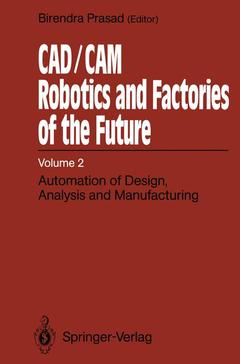CAD/CAM Robotics and Factories of the Future, Softcover reprint of the original 1st ed. 1989 Volume II: Automation of Design, Analysis and Manufacturing
Langue : Anglais
Coordonnateur : Prasad Birendra

This volume is about automation - automation in design, automation in manufacturing, and automation in production. Automation is essen tial for increased productivity of quality products at reduced costs. That even partial or piecemeal automation of a production facility can deliver dramatic improvements in productivity has been amply demon strated in many a real-life situation. Hence, currently, great ef forts are being devoted to research and development of general as well special methodologies of and tools for automation. This volume re ports on some of these methodologies and tools. In general terms, methodologies for automation can be divided into two groups. There are situations where a process, whether open-loop or closed-loop, is fairly clearly understood. In such a situation, it is possible to create a mathematical model and to prescribe a mathe matical procedure to optimize the output. If such mathematical models and procedures are computationally tractable, we call the correspond ing automation - algorithmic or parametric programming. There is, however, a second set of situations which include process es that are not well understood and the available mathematical models are only approximate and discrete. While there are others for which mathematical procedures are so complex and disjoint that they are computationally intractable. These are the situations for which heuristics are quite suitable for automation. We choose to call such automation, knowledge-based automation or heuristic programming.
I: Computer-Aided Design.- 1. 1. Shape Optimization.- A Geometry-Based 2-Dimensional Shape Optimization Methodology and a Software System with Applications.- Optimum Design of Continuum Structures with SHAPE.- The Velocity Field Matrix in Shape Optimal Design.- Implementation Issues in Variational Geometry and Constraint Management.- I. 2. Probabilistic Design Optimization.- Probabilistic Vibration Analysis of Nearly Periodic Structures.- Experience Gained From First-Order Reliability Methods (FORM) in Structural Analyses.- Reliability Analysis of Layered Cylindrical Structures under Combined Mechanical and Thermal Loads.- Design Reliability Optimization Using Probabilistic Design Approach and Taguchi Methods.- I. 3. Optimum Design Applications.- Optimization of Frame Structures with Thin Walled Sections of Generic Shape.- Optimal Design of Box Beams with Coupled Bending and Torsion Using Multiple Frequency Constraints.- Experiences on Analysis and Optimal Design of Pyramidal Truss Panels.- A Computational Procedure for Automated Flutter Analysis.- I. 4. Design Methodologies.- Axisymmetric Boundary Element Design Sensitivity Analysis.- Simultaneous Computation of Multiple Sensitivities by a Boundary Element Structural Analysis Formulation.- Lagrangian Interpretation of Nonlinear Design Sensitivity Analysis with Continuum Formulation.- A New Reanalysis Technique Suitable of Being used in Design Automation and Optimization.- Calculating Functionals for Arbitrary Geometries.- I. 5. CAD/CAM Automation.- A Graphics User Interface for Interactive Three Dimensional Free-form Design.- XCAD: A CAD Object-oriented Virtual Solid Modeler for an Expert System Shell.- II: Automation in Manufacturing.- II. 1. Planning and Control.- Decentralization of Planning and Control in CIM.- An Intelligent Tactical Planning System: The Integration of Manufacturing Planning Islands Using Knowledge Based Technology.- Automated Process Planning for Mechanical Assembly Operations.- An Unorthodox Approach to Job-Scheduling.- II. 2. Group Technology.- Development of a Group Technology Workstation.- A Comparison of Hierarchical Clustering Techniques for Part/Machine Families Formulation.- An Application of Fuzzy Mathematics in the Formation of Group Technology Part Family.- Automatic Generation of Production Drawings and Part Routings for Valve Spools.- III: Applications of Artificial Intelligence.- III. 1. AI Tools.- THINK: A C Library for Artificial Intelligence Tasks.- Using Artificial Intelligence Paradigms in Solving Manufacturing Problems Demonstrated in the CPC Stacking/Destacking Expert System.- A LISP-Based Environment for Simulation of Robot Applications.- III. 2. AI Methodologies.- An Interactive Refutation Learning Approach for Skill Acquisition in Knowledge-Based CAD System.- KBSS: A Knowledge-Based System for Scheduling in Automated Manufacturing.- Action, Reflective Possibility, and the Frame Problem.- Development of AI-Based Automated Process Planning Systems.- Automated Fixture Selection for Rotational Parts.- III. 3. Decision Support Systems.- A Frame-Based User Enquiry Method for Supporting Strategic Operations Planning.- Construction of a Knowledge Base for the Detection of Decision Errors.- On Representing Human Heuristic Reasoning.- IV: Expert Systems.- IV. 1. Expert Systems for Diagnostics.- An Expert System to Diagnose Failures in Industrial Robots.- An Operations Analysis Expert System for Fiberglass Manufacturing.- Failure Detection and Diagnosis — Application to a Grinding-Classification Circuit.- IV. 2. Expert Systems for Design and Production.- Expert System for Specifying of CAD Software Systems.- An Expert System for IC Factory Design.- Towards an Expert System Architecture for Routine Design — Focusing on Constraint Representation and an Application Mechanism for Mechanical Design.- Knowledge-Based Design Aid for Axisymmetric Casting Parts.- IV. 3. Expert Systems for Scheduling, Assembly, and Planning.- Expert System Supervision of Robots During a Vision-Assisted Assembly Task.- Intelligent Lot-Size Advisor for MRP Systems.- Intelligent Scheduling Systems for Parallel Machines with Different Capability.- Expert System-Based Finite Scheduler.- of Volume I.- of Volume III.- Author Index (Volume II).
Date de parution : 08-2012
Ouvrage de 308 p.
15.5x23.5 cm
Disponible chez l'éditeur (délai d'approvisionnement : 15 jours).
Prix indicatif 52,74 €
Ajouter au panierThèmes de CAD/CAM Robotics and Factories of the Future :
© 2024 LAVOISIER S.A.S.
